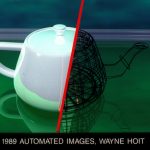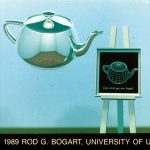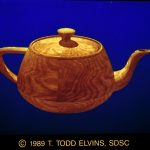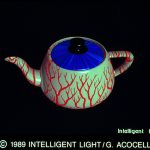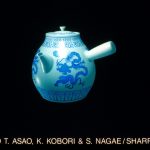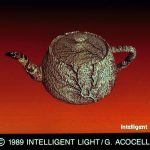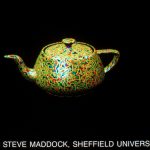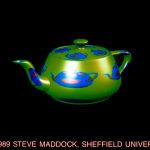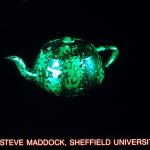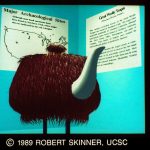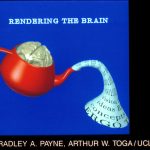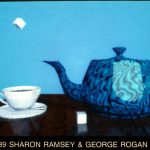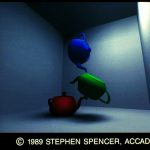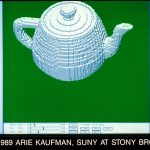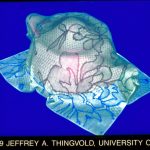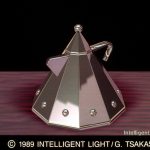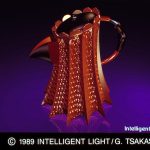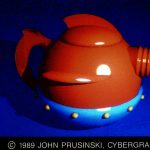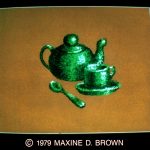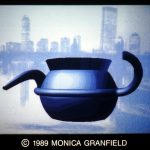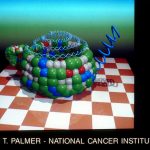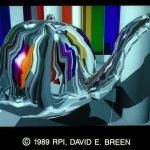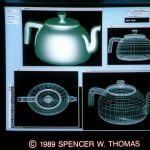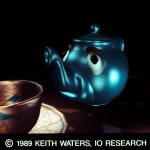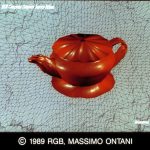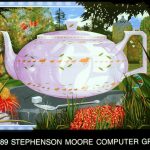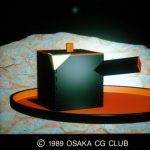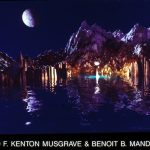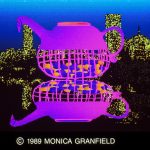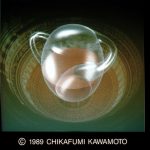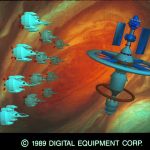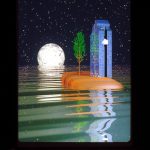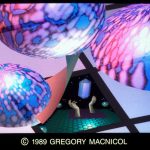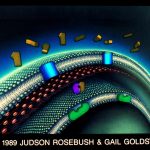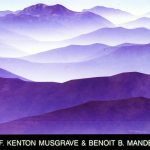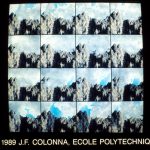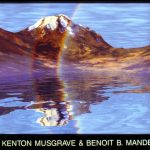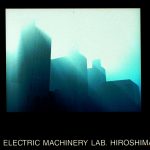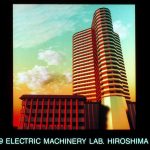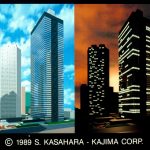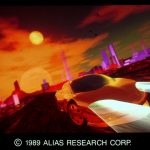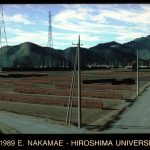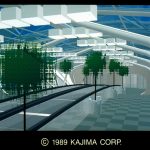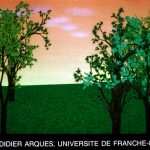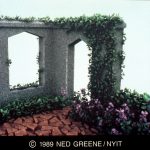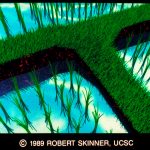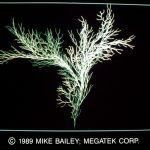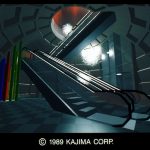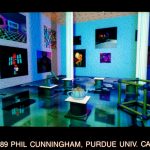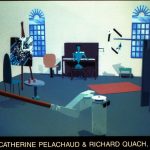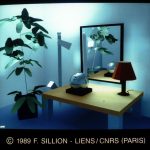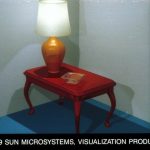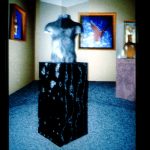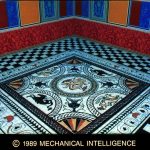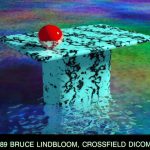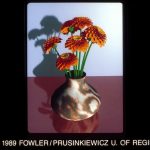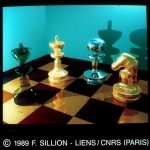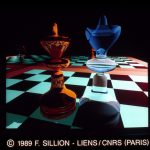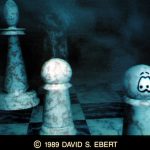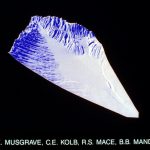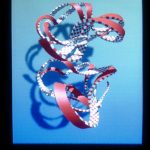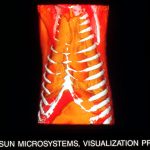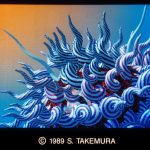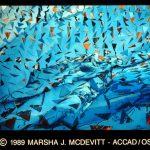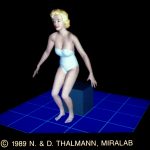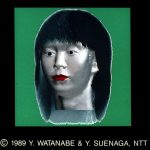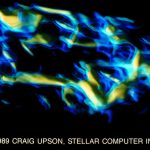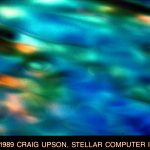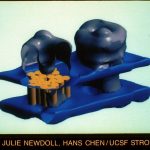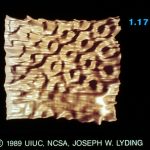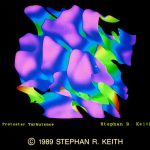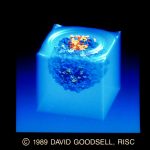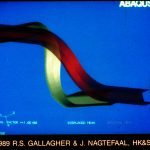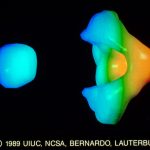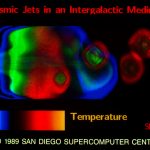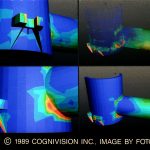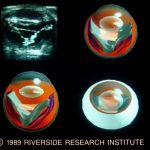“1989 Technical Slide Set”, 1989
Title:
- 1989 Technical Slide Set
Year:
- 1989
Conference:
Description:
SIGGRAPH ’89 Technical Slide Set Credits
Edited by Bruce Eric Brown
The technical slide set represents the state-of-the-art in computer- generated images. This year’s set has 78 slides. Each slide is printed here in black and white to facilitate locating information about the images. The full color 35mm slide set can be ordered from: ACM order department, P.O. Box 64145, Baltimore, MD 21264; 1-800-342-6626. The ACM order number for the SIGGRAPH ’89 technical slide set is 915890. The cost is $33 for members; $44 for non-members.
1. Newell’s Nightmare by Wayne E. Hoit. The work was created on the “ELECTROGIG II” 3-D print and animation system by Automated Images. Tbe objects were created using solid geometry and the image was ray traced. Hardware used was a Silicon Graphics personal Iris and photographed on a Matrix QCR-Z. Contact: Wayne E. Hoit, Automated Images U.S.A., Incorporated, 2030 M St. NW, Suite 703, Washington, D.C. 20036, (202) 331-1628, (202) 331-1723 FAX.
2. Services Rendered by Rod G. Bogart. The scene was ray traced at a resolution of 1536 x 1536. The ray tracing features depth of field and soft shadows. An inspiration credit goes to Rene Magritte. The software used was the Alpha I modeling and rendering system on a personal Iris workstation with a QCR camera. The work was performed at the University of Utah. Contact: Rod G. Bogart, University of Michigan, Chrysler Center, Room 229, 2121 Bonisteel Road, Ann Arbor, Ml 48109, (313) 936-3648.
3. Plywood Teapot by T. Todd Elvins. The image was rendered on a Sun 3/60 with a ray tracer written by John Peterson at the University of Utah. The rendering time was 30 hours. The teapot geometry (B-spline surfaces) was obtained from the Alpha I research group, University of Utah. Contact: T. Todd Elvins, San Diego Supercomputer Center, 10100 Hopkins Dr., La Jolla, CA 92037, (619) 534-5128, el vinst@sds.sdsc.edu.
4. Eyeball Teapot by Gordon Aco- cella. The teapot was created with Intelligent Light software and ren- dered on an Apollo workstation. The slide was shot on a Matrix PCR film recorder. Contact: Intelligent Light, P.O. Box 65, Fairlawn, NJ 07410, (20 I) 794-7550.
5. Teapot with Dragon Texture by T. Asai, K. Kobori and S. Nagae. The image was made with in-house software running on the IX-7 (32 bits EWS) coupled with a 24 bit frame buffer. The Oriental teapot model was constructed by revolution sur- faces and Coons surfaces, and converted to triangle polygons for rendering. The textures (dragon, arabesque pattern, etc.) were hand made using software painting capabilities. Contact: T. Asai and K. Kobori, Computer Systems Laboratories in Engineering Center, Sharp Corporation, 2613-1 Ichinomoto-cho, Tenri 632, Japan, 7436-5-1321; S. Nagae, University of Osaka Prefecture, 4-cho_ Mozu, Umemachi, Sakai 591, Japan, 0722-52-1161.
6. In Vein Teapot by G. Acocella. The teapot was created? with Intel- ligent Light software and rendered on an Apollo workstation. The slide was shot on a Matrix PCR film recorder. Contact: Intelligent Light, P.O. Box 65, Fairlawn, NJ 07410, (20 I) 794-7550.
7. Thin Film Interference and a Teapot by Stephen C. Maddock. Color is generated by modeling light interference in a thin surface film, the thickness of which is modulated by a turbulence function. The image was generated using in-house soft- ware on a RM Nimbus PC with an Ikon 24-bit pixel engine (frame buffer). Contact: Stephen C. Maddock, Department of Computer Science, Sheffield University, Portobello Centre, Pitt Street, Sheffield, S 1 4DD U.K.
8. Recursion with a Teapot by Stephen C. Maddock. Mip-mapping is employed while recursively wrap- ping teapots onto the patches of other teapots. The image was generated using in-house software on an RM Nimbus PC with an Ikon 24-bit pixel engine (frame buffer). Contact: Stephen C. Maddock, Department of Computer Science, Sheffield University, Portobello Centre, Pitt Street, Sheffield, SI 4DD U.K.
9. Turbulence on a Teapot by Stephen C. Maddock. The turbulence effect is procedurally generated by adding noise to alternate light and dark slabs of col.or. The image was generated using in-house software on an RM Nimbus PC with an Ikon 24- bit pixel engine (frame buffer). Contact: Stephen C. Maddock, Department of Computer Science, Sheffield University, Portobello Centre, Pitt Street, Sheffield, S 1 4DD U.K.
10. Great Woolly Teapot by Robert Skinner. The image was created using a particle system generator and renderer by the author on a Silicon Graphics Iris 4D/50GT connected to a Dunn camera. A particle system was procedurally grown onto a polygonal approximation of the teapot. The hair, teapot and display case were then rendered using an A-buffer algorithm. Contact: Robert Skinner, 225 Applied Science, University of California, Santa Cruz, CA 95064.
11. Rendering the Brain by Bradley A. Payne and Arthur W. Toga. This slide was produced in the Laboratory of Neuro Imaging, Department of Neurology at the UCLA School of Medicine. The staff of the Laboratory of Neuro Imaging all contributed to the work. Contact: Arthur W. Toga, Department of Neurology, Reed Neurological Research Center, 710 Westwood Plaza, UCLA School of Medicine, Center for the Health Sciences, I 0833 Le Conte A venue, Los Angeles, CA 90024- 1769.
12. One Lump or Two? by Sharon Ramsey and George Rogan. Ray traced image done on the Silicon Graphics 4D/80GT workstation with in-house experimental software using texture maps and bump maps. Bump mapping done with spectral density functions. The teapot is a modified Newell teapot and is texture mapped with a malachite pattern produced from a spectral density function. Sugar cubes and table top are bump mapped surfaces. Contact: Sharon L. Ramsey, ALCOA Technical Center, Route 780, 7th Street Road, ALCOA Center, PA 15069, (412) 337-2694.
13. Radiosi-tea #2 by Stephen Spencer. The environment was created in “chalk,” an environment creation and animation system writ- ten by John Donkin of the Advanced Computing Center for the Arts and Design. The environment was cal- culated and rendered using software running on the Ohio Supercomputer Center’s Cray X/MP supercomputer and.a Sun 3/60 workstation. Thanks to Jeff Light of ACCAD for the slides. Contact: Stephen Noel Spencer, ACCAD, The Ohio State University, 1224 Kinnear Road, Columbus, OH 43212, (614) 292-3416.
14. Voxel Teapot by Arie Kaufman. The display program was written by Kaufman and Li using SunCore and CUBE architecture software on Sun 3 and Sun 4 workstations. The Newell teapot was generated from 32 Bezier surfaces into a 643 cubic frame buffer of voxels. Contact: Arie E. Kaufman, Department of Computer Science, SUNY at Stony Brook, Stony Brook, NY 11794-4400.
15. There is a Teapot Under There by Jeffrey A. Thingvold. The Alpha- I modeling and rendering software running on a Sun workstation created the image. Physically based model- ing of surfaces, with intersection detection to simulate a draping surface over a static model was used to create the surface. Contact: Jeffrey A. Thingvold, The University of Utah, Computer Science Department, 3450 MEB, Salt Lake City, UT 841 I 2, (80 I) 581-8377.
16. Rossi by G. Tsakas. The teapot was created with Intelligent Light software and rendered on an Apollo workstation. The slide was shot on a Matrix PCR film recorder. Contact: Intelligent Light, P.O. Box 65, Fairlawn, NJ 07410, (20 I) 794-7550.
17. Anhinga by G. Tsakas. The teapot was created with Intelligent Light software and rendered on an Apollo workstation. The slide was shot on a Matrix PCR film recorder. Contact: Intelligent Light, P.O. Box 65, Fairlawn, NJ 07410, (201) 794- 7550.
18. Smokin’ Pot by John Prusinski. This is a still frame from an animation and is a good example of ray tracing on a small system. The Amiga 2000 was used running Sculpt- Animate 4D software from Byte by Byte, Inc. Contact: John Prusinski, CyberGrafix, 159 South Mountain Road, New City, NY I 0956, (914) 634-528 I.
19. Tea Time ’79 by Maxine D. Brown. The image was created in 1979 using an in-house paint system on a developmental HP 26xx color graphics terminal at Hewlett- Packard, Data Terminals Division, Cupertino, CA. The paint system was initially written as a tool to help the engineers designing the color monitor to quickly put colors on the screen, but the allure of an electronic palette was too much to pass up. What better subject to draw when giving demos to HP management than the classic teapot? (Besides, mandrills are too hard!) Contact: Maxine D. Brown, Electronic Visualization Laboratory, University of Illinois at Chicago, Box 4348 M/C 154, Chicago, IL 60680, (3 I 2) 996-3002.
20. Untitled by Monica Granfield. The image was created on a Geni- graphics PGP paint system utilizing the 3D software package, “Model Maker.’? Contact: Monica Granfield, 205 Colony Manor, Rochester, NY 01423.
21 . Molecular Teapot by Thomas C. Palmer. This image displays various molecular visualizations mapped onto teapot data. The body and handle of the teapot are modeled with familiar CPK spheres. The spout was built by taking an amino acid sequence in alpha helix conformation and mapping it onto the spout curve. The lid consists of a supercoil of DNA. This primitive organism, teapoticus newellum, (seen here in its natural state) replicates infrequently throughout the year. In late July, however, it undergoes a frenzy of reproduction and has been known to mutate into a variety of forms. The image was created on locally developed modeling and ray tracing software and displayed on a Silicon Graphics Iris 4D/70GT workstation. Contact: Thomas C. Palmer, National Cancer Institute – FCRF, P.O. Box B, Building 430, Frederick, MD 21701, (301) 698-5797.
22. Gothic Softea #3 by David E. Breen. Contact: David E. Breen, Rensselaer Design Research Center, Rensselaer Polytechnic Institute, Troy, NY 12180-3590, (518) 276- 6751.
23. Teapot Mold Design by Spencer \V. Thomas. This is a computer generated image of a teapot designed using the Alpha-I solid modeling system. The shape is made up of everal B-spl ine surfaces, which were created as swept surfaces or urfaces of revolution. A mold for the teapot was created from this design. It was milled from a lock of aluminum using a numerically-controlled milling machine at the University of Utah. The machining code was generated directly from the B-spline surface representation. Contact: Spencer \V. Thomas, Electrical Engineering and Computer Science Dept., University of Michigan, Ann Arbor, MI 48109-2110, (313) 936- 2616.
24. Spit the Pot by Keith Waters. One image of a sequence where Spit- the-Pot draws back his snout (using muscle controls) and spits tea into rhe cup. The software was “3D- Designer,” a package developed by IO Research Ltd. Contact: Keith \ arers, Schlumberger Lab for Com- purer Science, 8311 North RR 620, P.O. Box 200015, Austin, TX 78720-0015, (512) 331-3700.
25. Teapots by Massimo Ontani. The image is a study in three- dimensional modeling. The model was built with Crystall 30 and then deformed using software written for that purpose. Contact: T. Redaelli Spreafico, RGB Computer Graphics ervice, s.r.l., V.le Piave, 17 – 20129 Milano, Italy, 02/783992, 02/783325 FAX.
26. An English Country Garden by Tim Duke. The image was produced on Stephenson Moore Computer Graphics’ Silver Tree 8K paint system and imaged on a Solitaire. Contact: Bob Shillito, Stephenson Moore Computer Graphics, King William House, 13 Queen Square, Bristol BS I 4NT, England, (0272) 279181, (0272) 299158 FAX.
27. Japanese Traditional Tea Pot by Chikafumi Kawamoto, Hiroyuki Ishii, Sadahiko Nagae, Tomio Taira and Masayoshi Sawarura, the Osaka Computer Graphics Club KINTS Group. The hardware used was the DEC Micro VAX II with Sharp design CAD system software. A 30 surface model and Phong shading were utilized to render the image in about 60 minutes of CPU time. Contact: Sadahiko Nagae, professor of Kinki University, Tomigaoka 6-5-18, Nara, Japan.
28. The Incandescent Teapot by F.K. Musgrave, C.E. Kolb and B.B. Mandelbrot. This image is ray traced using the “grid tracing” algorithm described in the SIGGRAPH ’89 paper by Musgrave, Kolb and Mace. Note the small glowing teapot. The hardware used was a Silicon Gra- phics 4O70/GT and an Encore Multimax with the Optik ray tracer and custom terrain modeling software. Contact: F. Kenton Musgrave, Department of Mathematics, Yale University, Box 2155, ( 12 Hillhouse Avenue), New Haven, CT 06520, (203) 432-4016.
29. Untitled by Monica Granfield. The image was created on a Geni- graphics PGP paint system. Contact: Monica Granfield, 205 Colony Manor, Rochester, NY 01423.
30. Klein’s Pot by Chikafumi Kawa- moto. The image was produced on a DEC MicroVAXII with a Graphics M-508, O-Scan GR-2424 and a Sharp JX-450 scanner. The software was the Sharp design CAD using 30 surfaces and Phong shading. The CPU time expended was four hours. Contact: Chikafumi Kawamoto, 2-11-26, Sugiyamate, Hirakata- shi, Osaka 573-0 I, Japan.
31. Outpost: Jupiter by Digital Equipment Corporation. This image demonstrates the use of PEX (PHIGS/PHIGS+ extension to X) in the x window system environment. PEX provides the support for 3D standards (PHIGS, PHIGS+, GKS- 3D) in the network environment of X. This image was created interactively in the X envirnnment with dxmodel, an in-house PEX test and demo utility. It illustrates the use of the smooth (Gouraud) shading, specular reflection, depth- cuing and hidden surface removal that are supported in PEX. The spacestation and gunstar models are courtesy of Digital Productions. The background image was digitized from a NASA/ JPL photograph of Jupiter’s Great Red Spot and was installed as the window’s background pixmap. The image was created on a VAXstation 3520 running an X server with the PEX extension and recorded using a Matrix QCR film recorder. Contact: Randi J. Rost, Digital Equipment Corporation, 100 Hamilton Avenue, Palo Alto, CA 9430 I, ( 415) 853-6721.
32. Surrealistic Grain Elevator by A. Snider, N. Fuller and P. Prusin- kiewicz. The artists and pro- grammers used in-house modeling software and rendered the image with “rayshade” by Craig Kolb of Yale University. The hardware used was a Silicon Graphics Iris 4D/60 with a Matrix 6000 film recorder. The image is a ray traced scene. The tree is generated by an L-system. The elevator is modeled using a construction-based system which performs Euclidean constructions in 3D. Procedural textures are used throughout the scene. Contact: Przemyslaw Prusinkiewicz, Department of Computer Science, University of Regina, Regina, Saskatchewan, Canada S4S OA2, (306) 585-4061.
33. Untitled by Gregory MacNicol. The image is a frame from a film. It was produced on an IBM PC/AT with a Targa 16 board running Crystal 3D software. Contact: Gregory MacNicol, 222 S. Branciforte, Santa Cruz, CA 95062, (408) 426- 0403.
34. Beta Lactamase by Judson Rosebush and Gail Goldstein. This image was created using a Harris 800 with VISIONS, a proprietary soft- ware package. Yellow drug mole- cules pass through blue porens in a cell wall, binding either with the purple enzymes or green receptors sites. Behavior of the yellow drug -varies as a function of pH and enzyme concentrations. Contact: Judson Rosebush, Rosebush Visions Corporation, 25 West 45th Street, New York, NY 10036.
35. Semi-globalized Spectral Syn- thesis by Ken-ichi Anjyo and Kiyot- sugu Ikezawa. The image was made using HRL rendering software on the main frame HITAC M 680H; stochastic modeling software on the Hitachi 2050G workstation. The stochastic scene was depicted by semi-globalized spectral modeling. In the new modeling approach, the stochastic primitives are defined and integrated through set- theoretic operations among them. Each primitive has the spectral features which are separated into two parts: (I) the directional property a wave-like object generally has; (2) the silhouette property that is defined by the cross sectional spectral functions. These properties are independently specified, so that a variety of objects are described as illustrated in the image. Contact: Ken-ichi Anjyo, Hitachi Research Laboratory, Hitachi Ltd., 4026 Kuji-cho Hitachi- shi lbaraki-ken 319-12, Japan, 294-52-5111.
36. Carolina by Kenton Musgrave and Benoit B. Mandelbrot. This image is an illustration from the SIGGRAPH ’89 paper by Musgrave, Kolb and Mace. The terrain patch is a “noise-synthesized” fractal ren- dered with the “grid tracing” algorithm. The hardware used was a Silicon Graphics 4D70/GT and an Encore Multimax with the Optik ray tracer and custom terrain modeling software. Contact: F. Kenton Musgrave, Department of Mathematics, Yale University, Box 2155, (12 Hillhouse Avenue), New Haven, CT 06520, (203) 432-4016.
37. Cloud Dynamics by J.F. Colonna. This image shows 16 frames from a film made on cloud dynamics. On the mountains can be seen the self shadows of mountains and the shadows of clouds. Contact: Jean-Franco-is Colonna, GSV- LACTAMME, Ecole Polytechnique, 91128 Palaiseau Ced ex, France 33-1-60-10-40-53.
38. Spirit Lake by F. Kenton Mus- grave and Benoit B. Mandelbrot. This image is an illustration from the SIGGRAPH ’89 paper by Musgrave, Kolb and Mace. The terrain patch is a “noise-synthesized” fractal ren- dered with the “grid tracing” algorithm. The hardware used was a Silicon Graphics 4D70/GT and an Encore Multimax with the Optik ray tracer and custom terrain modeling software. Contact: F. Kenton Musgrave, Department of Mathematics, Yale University, Box 2 I 55, ( 12 Hillhouse Avenue), New Haven, CT 06520, (203)432-4016.
39. Sunlight by Eihachiro Nakamae, Kazufumi Kaneda, Takashi Okamoto and Tomoyuki Nishita. The software used was in-house running on a Silicon Graphics 4D workstation. The image depicts beam and fog effects caused by direct sunlight and skylight considering both scattering and absorption due to vapor and aerosols in the atmosphere. Contact: Eihachiro Nakamae, Hiroshima University, Electric Machinery Lab., Saijo-cho, Higashi-hiroshima 724, Japan, 81-824- 22-711 I, ext. 3445.
40. Skylight by Eihachiro Nakamae, Kazufumi Kaneda, Takashi Okamoto and Tomoyuki Nishita. The software used was in-house running on a Silicon Graphics 4D workstation. The image displays the building whose walls are made of aluminum, . taking into account the spectral distribution of direct sunlight and skylight. Contact: Eihachiro Nakamae, Hiroshima University, Electric Machinery Lab., Saijo- cho, Higashi-hiroshima 724, Japan, 81-824-22-7111, ext. 3445.
41. Two Scenes of Shinjuku by S. Kasahara. The modeling was per- formed with “CATIA,” a 3D CAD system and rendered with “REALS,” an in-house ray tracing software package. The hardware for modeling was an IBM 4381 and the rendering was done on a “Magic” high speed graphic engine. An actual photograph is mapped on a virtual sphere for sky representation because ray tracing requires sky data from all directions. The resolution of the image is 1400 x I 024 and took 32 minutes to render. Contact: Shinichi Kasahara, Information Processing Center, Kajima Corporation, 6-5-30 Akasaka Minato-ku, Tokyo 107 Japan, (03)-5561-2111.
42. Aerocar by Stanley Liu. The software used was the Alias/2 design and animation system running on a Silicon Graphics Iris 4D. A shadowy car on a shadowy planet. The car was modeled on the Alias/2 system using spline modeling techniques. Reflections on the car are created by ubic reflection mapping techniques. Sky and cloud background is a Natural Phenomena (TM) procedure. Two suns indicate this ar is definitely out of this world. Contact: Keith Raymond, Alias Research, Inc., 110 Richmond St. East, Toronto, Ontario, Canada MSC IP!, (416) 362-9181.
43. Terrain Model by Eihachiro Nakamae, Kazufumi Kaneda and Fujiwa Kato. The software used was in-house running on a Silicon Graphics 4D workst ation and a SEQUENT S8 l computer. In order to pre-evaluate visual impact of large scale construction, a technique for overlaying computer-generated images of a plant onto background images created from cartographic data and aerial photographs is employed. Contact: Eihachiro Nakamae, Hiroshima University, Electric Machinery Lab., Saijo-cho, Higashi-hiroshima 724, Japan, 1-824-22-7111, ext. 3445.
44. Kawasaki Safety Intelligent Plaza I by Kajima Corp. The modeling was performed with ?’CATIA,” a 3D CAD system and rendered with “REALS,” an in- house ray tracing software package. The hardware for modeling was an IBM 4381 and the rendering was performed with an IBM 5080 graphics system and Dicomed film recorder. This image was generated using a building model which had been designed on CATIA by A. Scott Howe, architect. Contact: Shinichi Kasahara, Information Processing Center, Kajima Corporation, 6-5-30 Akasaka Minato-ku, Tokyo I 07, Japan, (03)- 5561-2111.
45. Sundown by Didier Argues. An illustration from the author’s SIG- GRAPH ’89 paper. The image has a few big trees in front of the sun and little white clouds in the sky. Contact: Didier Argues, Laboratoire Informatique de Besancon, Univer- site de Franche-Comte, 16, Route de Gray, 25030 Besancon Cedx, France.
46. Organic Architecture by Ned Greene. The “Gaudi” growth pro- gram and NYIT animation system were used on the Sun 4 with Ikonas frame buffer. This is a frame from the animation shown ? in the SIGGRAPH ’88 film show depicting growth in voxel space. Contact: Ned Greene, 102 Sea Cliff Avenue, Sea Cliff, NY 11579, (516) 759- 1869.
47. Reflections of Indonesia by Robert Skinner and Cathy Hirata Skinner. The image was created using a particle system generator and renderer on a Silicon Graphics Iris 4D/50G T connected to a Dunn camera. A particle system was procedurally grown for the grass, rice shoots and reflections, then rendered using an A-buffer algorithm. Contact: Robert Skinner, 225 Applied Science, University of California, Santa Cruz, CA 95064.
48. Fractal Bush by Mike Bailey. The image is a fractal bush generated in 3D using an L-System equation of: F-> FP+[>+F-F-F]v-[<F+F+F] where: +/- are yaw right/left, </> are roll right/left, “/v are pitch up/down [/] are save/restore graphics state. Contact: Mike Bailey, 10535 Quail Springs Court, San Diego, CA 92131.
49. Kawasaki Safety Intelligent Plaza II by Kajima Corp. The modeling was performed with “CATIA,” a 3D CAD system and rendered with “REALS,” an in- house ray tracing software package. The hardware for modeling was an IBM 4381 and the rendering was performed with an IBM 5080 graphics system and Dicomed film recorder. This image was generated using a building model which had been designed on “CATIA” by A. Scott Howe, architect. Contact: Shinichi Kasahara, Information Processing Center, Kajima Corporation, 6-5-30 Akasaka Minato-ku, Tokyo 107, Japan, (03)- ?5561-2111.
50. CADLAB Museum by Phil Cunningham. The image was gener- ated with in-house software render- ing package running on a Silicon Graphics Iris 4D workstation. The scene was modeled and ray traced as part of a CADLAB research project for machine vision based rendering. Contact: Phil Cunningham, Purdue University CADLAB, Potter Engineering Center, W. Lafayette, IN 47907, (317) 494-5944.
51. Playroom by Catherine Pela- chaud and Richard Quach. The image is a playroom scene from an animation sequence of moving articulated figures. It was created on a Silicon Graphics Iris 4D/70GT running the modeling software PEABODY and JACK with ray trace software by Welton Becket III. Contact: Norm Badler, CIS Moore School Graphics Lab/6389, 200 South 33rd St., Philadelphia, PA 19104.
52. Specular Hevea-2 by Francois Sill ion. This image was created with the Light Interreflection Calculation System, a combination of ray tracing and radiosity. The software was running on an HP835/5RX and a Bull DPX 5000. The Hevea Tree database is courtesy of AMAP. This is a demonstration of a global rendering system, modeling specular and diffuse reflection. Contact: Francois Sillion, Liens-CNRS, 45 rue D’Ulm, 75005 Paris, France, (33) 1-43265996.
53. Lamp by Sun Microsystems. Rendered using experimental ray tracing software and modeled using tools. The traditional global illum- ination model has been extended to include “lamp shading,” that is, surface which are diffuse transmit- ters. Contact: Tim Van Hook, Sun Microsystems, P.O. Box 13447, Research Triangle Park, NC 27709, (919) 460-8336.
54. Art Gallery 1 by David S. Ebert. This scene features solid texturing of the walls, floor, marble torso and pedestals and wooden vases and picture frames. The pictures on the wall are prerendered scenes. The scene features 12 light sources. Torso data by Don Stredney. Texturing and rendering software by Ebert running on a HP9000/370 SRX. Contact: David S. Ebert, Ohio State University, Department of Computer Science, 2036 Niel Avenue, Columbus, OH 43210, (614) 292-6551.
55. Fishbourne Palace by Mechanical Intelligence. The picture is of the Fishbourne Palace, Roman, West Sussex, England, reconstructed dining room with dolphin mosaic. The model was based on archaeological data collected under the direction of Dr. Barry Cunliffe, Oxford. The model is an attempt to reconstruct as accurately as possible the dining room N-7 and its courtyard in the early third period of its existence, (c.C.E. 100-280). The mosaic was reconstructed from drawings and photographs of the original. The image is rendered at IO I 4 x 676 by 32 bit/pixel. The model consists of over 3,500 primitives, 13 texture maps and 5 procedural textures. The rendering software was Renderman (TM). Some of the texture was created with Pixe!Paint. No modeler was used. The hardware included an Apple Macintosh II, 8MB and Supermac Spectrum 24. The graphics accelerators used were 4 Levco Translink processors each with 4 MB of RAM. Contact: Janice Cornforth and Craig Davidson, Mechanical Intelligence, 922 Grange Hall Road, Cardiff, CA 92007, (619) 436-1455.
56. Dinner for Doris by Bruce Lindbloom. The image was rendered on a DEC VAX 11/785 at 1279 x 987 resolution and interpolated up to 3318 x 2327 using the piecewise cubic reconstruction filter of Mit- chell and Netravali (SIGGRAPH ’88 proceedings). Solid texture, bump mapping and distributed ray tracing techniques were used. The final image was filmed on a Dicomed D48 film recorder. Contact: Bruce J. Lindbloom, Crosfield Dicomed Inc., 11401 Rupp Drive, P.O. Box 246, Minneapolis, MN 55440-0246, (612) 895-3000, (612) 895-3258 FAX.
57. Zinnias by Deborah Fowler and Przemyslaw Prusinkiewicz. The artists and programmers used in- house modeling software and rendered the image with “rayshade” by Craig Kolb of Yale University. The hardware used was a Silicon Gra- phics Iris 4D/60 with a Matrix 6000 film recorder. The flower structure is based on a biologically motivated mathematical model of spiral phyliotaxis in flower capitula, proposed by H. Vogel and J.N. Ridley. Contact: Przemyslaw Prusinkiewicz, Department of Computer Science, University of Regina, Regina, Saskatchewan, Canada S4S 0A2, (306) 585-4061.
58. 1st Cartesian Vision by J.P. Thirion and M.P. Cani. Beam tracer software by J.P. Thirion and auto- matic generation of skin on skeleton by M.P. Cani. The software ran on the Bull SPS9 and Silicon Graphics Iris 3020. Beam tracing uses spatial coherence to improve ray tracing run time performance. All rays were computed using beams,. even relected, refracted and shadow rays. The curved surfaces are made with automatic skin generation system. Contact: Jean-Philippe Thirion, Laboratoire D’informatique de L’Ecole Normale Superieuve (L.1.E.N.S.), 45 rue d’Ulm, 75005, Paris, France, 33- 1-45-58-12-33.
59. Icy Queen by J.P. Thirion. Beam tracer software by J.P. Thirion running under Unix 4.3 or V deve- loped in the LIENS. The software ran on the Bull SPS9. Beam tracing improves ray tracing run time per- formance, especially for high reso- lution images. All rays were computed using beams, even reflected, refracted and shadow rays. Curved surfaces are allowed. Contact: Jean-Philippe Thirion, Laboratoire D’informatique de L ‘Ecole Normale Superieuve (L.I.E.N.S.), 45 rue d’Ulm, 75005, Paris, France, 33-1-45-58-12- 33.
60. Once A-Pawn a Foggy Knight by David S. Ebert. This is a still from a film entitled Once A-Pawn a Foggy Knight. The slide features solid textured marble chess pieces and 2D textured eyes. The main feature of the slide is the animated swirling smoke simulation. Texturing and rendering software by David Ebert running on an HP9000/370 SRX. Contact: David S. Ebert, Ohio State University, Department of Computer Science, 2036 Niel A venue, Columbus, OH 43210, (614) 292-6551.
61. Dry Wash by F.K. Musgrave, C.E. Kolb, R.S. Mace and B.B. Mandelbrot. This is an illustration from the SIGGRAPH ’89 paper by Musgrave, Kolb and Mace. It is an example of a “noise-synthesized” fractal terrain patch modified with erosion processes. The hardware used was a Silicon Graphics 4D70/GT with custom software. Contact: F. Kenton Musgrave, Department of Mathematics, Yale University, Box 2155, (12 Hillhouse Avenue), New Haven, CT 06520, (203) 432-4016.
62. A Time of Festival by Shinichi Takemura. ”I intended to express the happy time and joyfulness in the festival.” The curve forms in the picture are created by using a kind of sweep method along the double spiral lines. The outline of the shadow is diffused by using cell- automaton method. The image was made on an Epson 386 computer, Free-16 frame buffer and HC- I 000 digital video copy with software by the author. Contact: Shinichi Takemura, Science University of Tokyo, 1-14-18, Gohongi, Meguro-Ku, Tokoy, 153, Japan, (03)-712-0856.
63. Tree Sloth by ChuckMosher and Ruth Johnson. The image was made using Yoxvu, the volume rendering tool 1ha1 comes wi1h the Sun TAAC- 1 application accelerator. This image is a shaded surface volume rendering of a 128 x 128 x 197 CT scan of a tree sloth. The opacity of various structures can be interactively modified to show the skin surface or to reveal internal structures. The bones of the rib cage, shoulder blades and spine can be seen in the image on the right, as well as the trachea, lungs, heart and diaphragm. The CT data is courtesy ofEric Hoffman, UPA. Contact: Chuck Mosher, Sun Microsystems, Inc.. P.O. Box 13447, Research Triangle Park, NC 27709, (919) 469-8300.
64. Tentacles by Shinichi Takemura. This is an image of a creature living in somewhere in the cosmos which has alot of tentacles around its body. The image was made on an Epson 386 computer, Free-16 frame buffer and HC-1000 digital video copy with software by the author. Contact: Shinichi Takemura, Science University of Tokyo, 1-14-18, Gohongi, Meguro-Ku, Tokyo, 153, Japan, (03)-712-0856.
65. Triangle-wave by Marsha J. Mc- Devitt. The image was created using software developed at the Advanced Computing Center for the Arts and Design at the Ohio State University. Data generation software by John Donkin, Jeff Light, Steve Spencer and Marsha McDevitt. Scene description software by John Donkin. Rendering software by Scott Dyer. The hardware used included Sun 4/260 workstation, Parallex framebuffer, Barney digital scanner and Solitaire film recorder. Contact: Marsha J. McDevitt, ACCAD The Ohio State University, 1224 Kinnear Road, Columbus, OH 43212, (614) 292-3416.
66. Constraint-based Motion by N. & D. Thalmann. The hardware used is the Raster Technologies One/80 with software by N. Magnenoit- Thalmann and D. Thalmann. Marilyn stands up from a seat using multiple- constraints and dynamics. Contact: D. Thalmann, MIRALab, P. 0. Box 6128, Station A, Department of Computer Science, University of Montreal, Montreal, Canada H3C 317, (514) 343-6794.
67. Human Hair in the Backlight by Yasuhiko Watanabe and Yasuhito Suenaga. The image was made with “double z-buffer” method on the Silicon Graphics Iris 4D/70GT. All hairs are modeled based on trigonal prisms and wisps. The image was generated at a resolution of 1024 x 1024. Contact: Yasuhiko Watanabe, Vis NTT Human Interface Laboratories, 1-2 Kanagawa, 238-03, Japan, 81-468-59-83
68. Turbulent Boundary Layer by Craig Upson. This is a volume rendered image showing the pressure distribution of a three dimensional simulation of the turbulent boundary layer along a flat plate. The low pressure region shown in yellow is the location of high vorticity, indi- cating turbulent mixing. The image is by Craig Upson who ran on a Stellar GS I 000 and the simulation is by Stephen Robinson of NASA Ames who ran on the Cray XMP. Contact: Craig Upson, Stellar Computer Inc., 920 Hillview Ct. #180, Milpitas, CA 95025, (408) 946-0400.
69. Sometimes the Str angest ,Things Happen by Craig Upson. This slide is the result of using an ad hoc database to drive a volume renderer. The fluid structure seen in the image is purely accidental, but is none-the-less remarkably realistic. Contact: Craig Upson, Stellar Computer Inc., 920 Hillview Ct. #180, Milpitas, CA 95025, (408) 946- 0400.
70. Acetylcholine Receptor by Julie Newdoll and Hans Chen. The ace- tylcholine receptor, solidly rendered from data gathered from three dimensional electron microscopy combined with x-ray profile data. Polygonal surface data was gener- ated by PRISM software, written by Hans Chen, UCSF Agard Lab, which was then fed into DORET on the Ardent Titan. Graphics and image created by Julie Newdoll. Electron density research done by Alok Mitra in the lab of Robert Stroud. The blue sections are the membrane of a cell, with the protein (acetylcholine receptor) shown in lavender, with a channel that receives acetylcholine (during nerve synapse). This protein comes in mirror image pairs (a pair of them is represented here). The image is clipped in Z to portray the theoretical arrangement of the 20 helix bundles that form the channel. Contact: Julie Newdoll, School of Medicine, Department of Biochemistry and Biophysics, University of California SF, San Francisco, CA 94143- 0448, (415) 476-3937. 71. Molecular Diffusion on Single Crystal Gold Surface studied by STM by Mark Bajuk, Joseph W. Lyding, Jerome S. Hubacek and Roger T. Brockenbrough. A scanning tunneling microscope is used to study the diffusion of physisorbed mole- cules on a single crystal gold surface. The Wavefront Technologies and in-house software were used running on the Alliant FX/80 computer and the Silicon Graphics Iris 3130 workstation. Contact: Daniel Brady, Scientific Visualization Program, National Center for Supercomputing Applications, 152 Computing Applications Bldg., 605 E. Springfield Ave., Champaign, IL 61820, (217) 244-2003.
72. Protostar Turbulence by Ste- phan R. Keith. Protostar turbulence was generated using numerical simulation techniques on a Cray- XMP at NASA Ames Research Center. The data was transferred to a DEC VAX 8650, processed by GVS (General Visualization System) software written by S.R. Keith and visualized on a STAR Graphicon graphics display processor. The experimental research was performed by Bill Cabot and the visualization was performed by Stephan R. Keith. Contact: Stephan R. Keith, 424 Custer Road, Hayward, CA 94544, (415) 537-0964.
73. Polio Virus by D. Goodsell and A. Olson. This is a recreational view of polio virus. Coordinates are courtesy of J. Hogle. The RMSVO-. LUME software package, an in- house volume rendering program (J. Mo/. Graphics 7, (1989), 41-47) was used on a Convex Cl, C2 and Sun with TAACI to make the image. Contact: David Goodsell, Department of Molecular Biology – MB5, Research Institute of Scripps Clinic, La Jolla, CA 92037, (6 I 9) 554-4392.
74. S-rail by R. S. Gallagher. A dynamic analysis of an S-rail from an automotive frame. This is a deformed shape with Gouraud shading and translucency. Produced on a Tektronix 4336 workstation. Con- tact: Richard S. Gallagher, Hibbitt, Karlsson & Sorensen, Inc., I 00 Medway Street, Providence, RI 02906-4402, ( 40 I) 861-0820, ( 40 I) 861-0208 FAX.
75. Microscopic NMR Chemical Shift Images by Marcelino L. Bernardo Jr., Paul C. Lauterbur and Mark Bajuk. Microscopic NMR image of a cross-section of a water- filled tube within a Imm tube of benzene displaying, with color coding, the water-benzene chemical shift and magnetic susceptibility distortion effects perpendicular to the spatial image plane. The Wavefront Technologies and in- house software were used running on the Alliant FX/80 computer and the Silicon Graphics Iris 3130 workstation. Contact: Daniel Brady, Scientific Visualization Program, National Center for Supercomputing Applications, 152 Computing Applications Bldg., 605 E. Springfield Ave., Champaign, IL 61820, (217) 244-2003.
76. Cosmic Jets in an Intergalactic Medium-multiple Cloud by T. Todd Elvins. This is a frame from a movie. Radio observation of the heavens reveals energetic phenomena, like active galaxies with black holes at their cores, expelling jets of matter that extend across space for hundreds of thousands of light years. These jets often bend. While theory suggested that the jets bend around large-scale density inhomogeneties in the ambient medium-big clouds of cooler, denser plasma-the supercomputer simulation disproves this bending mechanism. The jets bum right through the clouds. Contact: T. Todd Elvins, Anke Kamrath, San Diego Supercomputer Center, 10100 Hopkins Dr., La Jolla, Ca 92037, (619) 534-5128, elvinst@sds.sdsc.edu.
77. Tension Leg Platform Stress Intensity by Mark Smith and Olin Lathrop. Stress intensity is color coded on a small section of a tension leg offshore oil platform. Different views are shown totally opaque, and with stress intensity mapped to opaqueness. This combination is useful for quickly identifying areas of high interest, while still providing good context. Interactive setup and previewing was done on an Apollo ON IO000VS 80 plane system using the alpha buffering hardware. Final images were computed in software on the ON IO000 at 4K resolution and then filtered to the 2K resolution shown. The finite element analysis was done by ANSYS. The image was produced directly with FOTO, Cognivision’s generic data visualization program. Contact: Cognivision, Inc., 319 Littleton Road, Suite 100, Westford, MA 01886, (508) 392-088 I.
78. 3D Reconstruction of an Eye using Ultrasound Images by A. E. Dumke, F. L. Lizzi, D. J. Coleman, A. L. Rosado and R. H. Silverman. 3D surface rendering of an eye with traumatic injury showing v-shaped retinal detachment with a horizontal bridging membrane. Purple shaded surface represents inner surface of thickened choroid. Rendering was synthesized from 17 ultrasonograms (shown in upper left quadrant) obtained in parallel planes. The image was generated using the Adage 3000 image processor and DEC VAX 11/780. Riverside Research Institute in collaboration with Cornell University Medical College. Research supported in part by NIH Grants EY0 1212 and EY03 I 83. Contact: Anne E. Dumke, Riverside Research Institute, 330 West 42nd Street, New York, NY I 0036, (212) 502-1800.
Publication Documents:
1989 Technical Slide Set Images:
